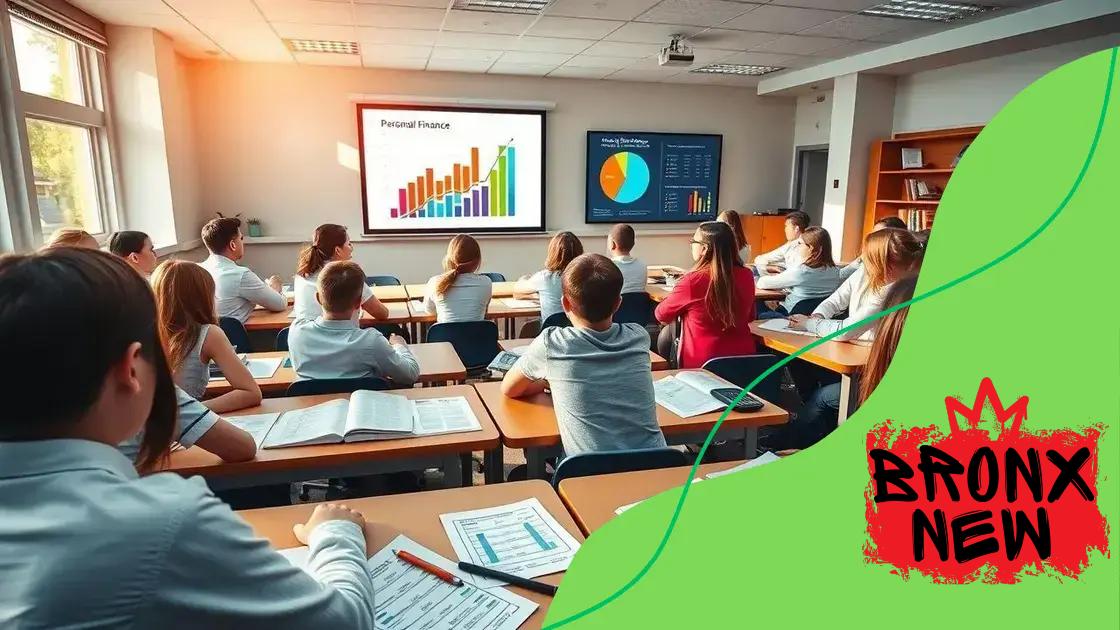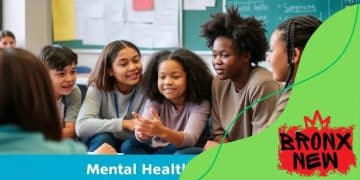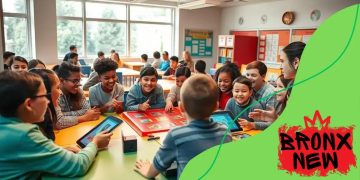Financial literacy programs in schools: essential for students

Financial literacy programs in schools equip students with essential money management skills, enhancing their ability to make informed financial decisions in adulthood.
Financial literacy programs in schools are becoming increasingly vital as students prepare for adult life. Have you thought about how these programs can shape their future decisions?
Importance of financial literacy for students
The importance of financial literacy for students cannot be overstated. Understanding how to manage money effectively is a crucial skill for success in today’s world. Students equipped with financial knowledge are better prepared to face challenges related to budgeting, saving, and investing.
Benefits of Financial Literacy
Schools that implement financial literacy programs provide students with practical knowledge that can benefit them throughout their lives. When students learn about finances early on, they develop skills that are essential in navigating adult responsibilities.
- Improved decision-making skills regarding money
- Increased ability to save for future goals
- Enhanced understanding of credit and debt management
- Greater potential for financial security
When students grasp concepts such as banks, interest rates, and investments, they gain confidence in their abilities to handle their finances. This knowledge translates into real-life applications, making them more informed consumers.
Real-Life Applications
For instance, understanding the value of compounding interest can encourage students to start saving early. They learn that even small amounts deposited regularly can grow significantly over time. This simple principle can have a lasting impact on their financial future.
Moreover, incorporating financial literacy into the curriculum can spark students’ interest in economics and personal finance, leading to potential career paths in finance, entrepreneurship, or business management. As they engage with real-world scenarios, students can better appreciate the relevance of financial education.
Investing in financial literacy means investing in a student’s future, ensuring they are well-prepared to tackle financial decisions as they grow. With these skills, they can thrive in both their personal and professional lives.
Key components of effective financial literacy programs
Effective financial literacy programs are built on several key components that ensure students gain the necessary skills to manage their finances. These components address various aspects of financial education, making the program well-rounded and impactful.
Core Curriculum Topics
At the heart of any good financial literacy program lie essential topics that all students should understand. These topics include budgeting, saving, investing, and understanding credit.
- **Budgeting:** Teaching students how to create a budget helps them manage their income and expenses effectively.
- **Saving:** It’s vital for students to learn the importance of saving for future goals and emergencies.
- **Investing:** Exposure to basic investment concepts can set the stage for long-term financial growth.
- **Credit Management:** Understanding how credit works empowers students to make informed decisions about borrowing.
By incorporating these topics into the curriculum, schools provide students with a solid foundation in financial literacy. Educators can enhance learning by using interactive activities and real-life scenarios, allowing students to apply their knowledge practically.
Engagement and Practical Application
Engagement is another critical component. Programs that involve hands-on activities capture students’ attention and make learning enjoyable. Activities like budgeting games, mock investment projects, and guest speakers from financial institutions can inspire students.
Furthermore, encouraging real-life applications of these lessons can significantly enhance student understanding. For example, students could manage a small budget for a class project, simulating real-life financial responsibilities. Such experiences can help students retain information better.
Additionally, parental involvement can reinforce the message learned in school. Programs that encourage parents to participate create a supportive environment for students, where financial discussions continue at home.
With these key components working together, financial literacy programs can make a tremendous difference in a student’s ability to manage their finances. By prioritizing these elements, schools can empower students to become confident and financially savvy adults.
How schools are implementing financial literacy education

Schools are increasingly recognizing the significance of financial literacy education for students. Many institutions are making efforts to integrate this essential skill into their curricula in various innovative ways. This integration prepares students to tackle financial challenges as they transition into adulthood.
Curriculum Integration
One effective method schools are using is incorporating financial literacy into the existing curriculum. For example, subjects like math, social studies, and economics can seamlessly include financial concepts. This approach allows students to learn through real-world applications.
- **Math Classes:** Using financial scenarios to teach concepts like percentages and interest rates.
- **Social Studies:** Exploring historical financial events and their impact on society.
- **Economics Classes:** Diving deeper into economic principles, budgeting, and the banking system.
Such integration helps students see the relevance of finance in their everyday lives. It not only teaches them essential skills but also keeps them engaged in their learning process.
Extracurricular Activities
Another way schools are emphasizing financial literacy is through extracurricular programs. Clubs focused on finance topics, such as investment clubs and economics clubs, allow students to explore these subjects in a fun and interactive environment. Participation in challenges like budgeting competitions can ignite students’ interest in managing money.
Engaging with local businesses and community organizations also opens doors for students to learn from real-life financial experiences. Field trips to banks or financial institutions give students firsthand insights into how money works in the real world.
Involving parents in financial literacy initiatives further enhances the learning experience. Schools can host workshops where parents and students collaborate on budgeting and saving exercises. This collaboration leads to stronger family discussions about finances, reinforcing what students learn at school.
By utilizing various implementation strategies, schools can effectively prepare students for a financially literate future. With these skills, students will grow into informed adults capable of making smart financial choices.
Challenges in teaching financial literacy
Teaching financial literacy comes with several challenges that educators face. Understanding these hurdles helps to create effective strategies for overcoming them and ensuring students receive a valuable education.
Curriculum Limitations
One of the significant challenges is the lack of a standardized curriculum. In many schools, financial literacy is not a core subject, so teachers may struggle to find resources tailored to their needs. This inconsistency can lead to varying levels of understanding among students.
- Resource Availability: Teachers often have limited access to teaching materials, making it difficult to deliver engaging lessons.
- Training and Support: Many educators are not adequately trained in financial topics, leading to a lack of confidence in teaching.
- Time Constraints: With tight schedules, fitting in financial literacy lessons can be a challenge for teachers.
These limitations can prevent effective financial education, making it essential to advocate for the incorporation of financial literacy into school curricula.
Student Engagement
Another challenge is keeping students engaged in financial education. Financial topics can sometimes be perceived as dull or irrelevant. Students may struggle to see how these concepts apply to their lives.
Using interactive methods can enhance student participation. Incorporating games, simulations, and real-world scenarios helps to make learning more relatable and fun. Students may find it easier to grasp complex topics when they can engage in practical applications. This connection can spark their interest and motivate them to learn.
Furthermore, addressing different learning styles among students is crucial. Some may prefer visual aids, while others might benefit from hands-on activities. Teachers can mix various teaching styles to reach a wider audience.
By being aware of these challenges, educators can better navigate the landscape of financial literacy education. They can develop creative solutions that ensure students understand the importance of managing their finances.
Success stories from schools with robust programs
Success stories from schools with robust financial literacy programs demonstrate the positive impact of effective financial education on students’ lives. These programs equip students with essential skills and knowledge, paving the way for their future financial success.
Case Studies of Successful Programs
Several schools across the country have implemented innovative financial literacy programs that yielded impressive results. For example, a high school in California introduced a comprehensive financial literacy curriculum that involved project-based learning.
- **Real Life Simulations:** Students participated in simulations where they had to manage a household budget, learn about taxes, and make investment choices.
- **Increased Engagement:** This hands-on approach led to increased student engagement, with many expressing newfound confidence in their financial knowledge.
- **Measurable Outcomes:** Assessment data showed that students improved their understanding of financial concepts significantly, scoring higher on standardized tests.
Another inspiring example comes from a middle school in New York that partnered with a local bank to create a program focusing on saving and investing. Students took field trips to the bank, where they learned about savings accounts and interest.
Many students began to open their savings accounts at the bank, demonstrating real enthusiasm for managing their finances. In surveys, parents reported that their children were talking more about personal finance at home, sparking important discussions about money management.
Similarly, a program in Texas combined digital tools with traditional learning methods. Students used financial apps to track their spending and savings. This integration of technology helped students connect financial concepts with their everyday lives.
Community and Parental Involvement
Schools active in fostering community and parental involvement have also seen notable success. Programs that include workshops for parents encourage family discussions about finances, reinforcing what students learn.
In one case, a school organized community events where students taught their parents what they learned in class. This approach not only solidified students’ knowledge but also engaged parents, creating a culture of financial literacy within families.
These success stories highlight the transformative power of well-implemented financial literacy programs in schools. By providing students with practical knowledge and skills, schools can significantly influence their future financial well-being.
FAQ – Frequently Asked Questions about Financial Literacy Programs in Schools
What are financial literacy programs?
Financial literacy programs are educational initiatives designed to teach students essential skills for managing money, such as budgeting, saving, and understanding credit.
Why is financial literacy important for students?
Financial literacy is crucial for students as it prepares them for real-life financial responsibilities, helping them make informed decisions about money in adulthood.
How do schools implement financial literacy education?
Schools implement financial literacy education by integrating it into existing subjects, offering extracurricular programs, and involving parents in financial discussions.
What challenges do educators face in teaching financial literacy?
Educators face challenges such as limited curriculum resources, varying student engagement, and a lack of training in financial topics, all of which can hinder effective teaching.





